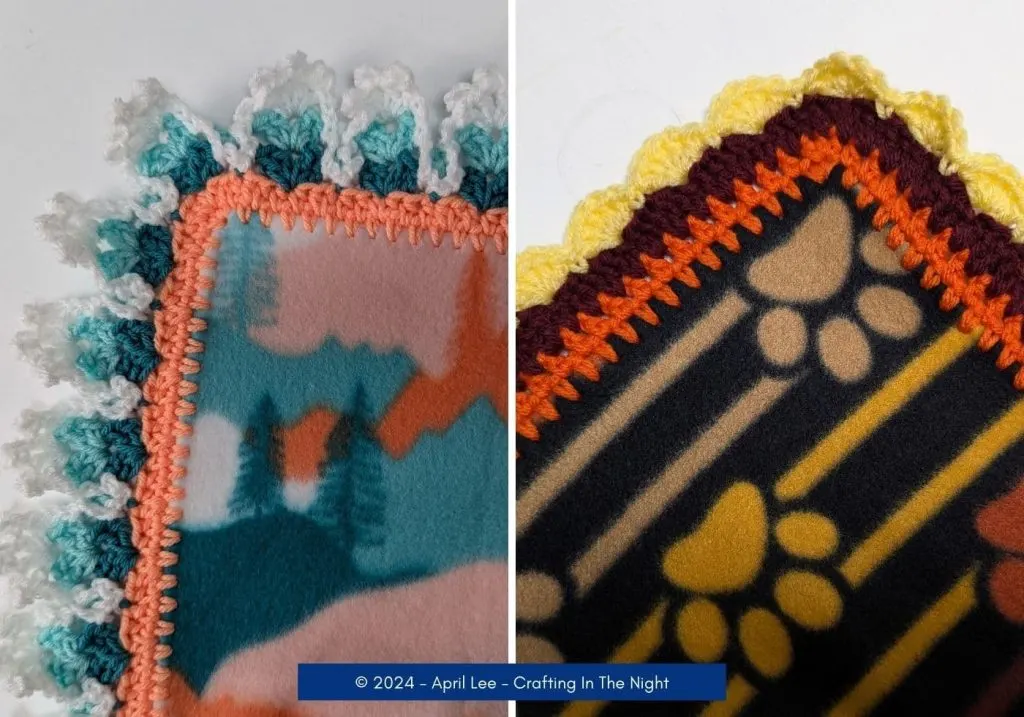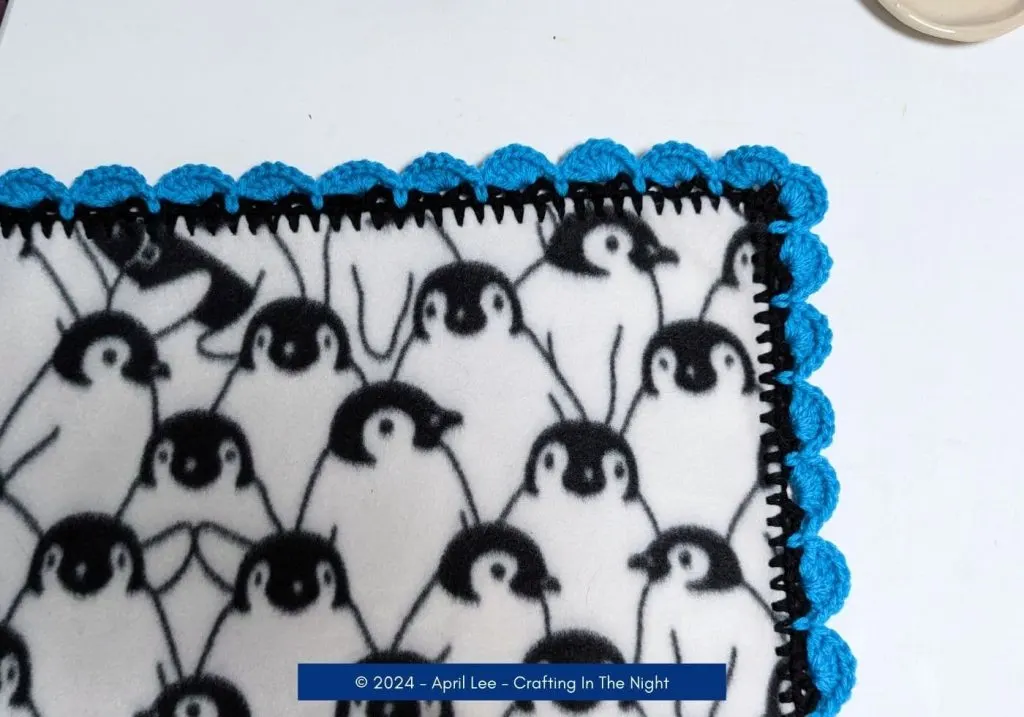Creating a cozy and beautiful crochet edge on a fleece blanket is both simple and rewarding. By adding a crochet border, you can transform a plain fleece blanket into a unique and heartfelt gift. This project is perfect, whether you’re making something for yourself or crafting a beautiful blanket to donate to charity.
When I first tried this, I was amazed at how quickly the crochet edge worked up and added a fun splash of visual interest to my blanket. It gives the fleece fabric that homemade touch and best of all, the fleece fabric is hole free making this a great project idea for baby blankets.
Using tools like a perforating blade and a crochet hook makes this project accessible for everyone, even beginners. The process involves crocheting into small holes made along the edge of your fleece. This technique allows the yarn to integrate nicely with the fabric.

Understanding the Basics
Creating a crochet edge on a fleece blanket can add a decorative and functional touch. Knowing the essentials, including what it is and what you’ll need, helps in making this project enjoyable and successful.
What Is a Crochet Edge Fleece Blanket?
A crochet edge fleece blanket combines the softness of fleece with a decorative crochet trim. This type of blanket uses fleece fabric as the base, which is cozy and warm. A crochet edge is created by stitching yarn around the perimeter, turning a plain piece into something visually appealing.
I’ve found that adding a crochet edge not only enhances the look but also helps the edges stay neat. This is especially nice if you’re looking to add a personal touch to a simple fleece blanket.
Materials Needed
- You get 14 Ergonomic Crochet Hooks,9 Yarn Needles,10 Stitch Markers,1 Scissors& Case.
- Crochet hooks with comfortable easy grip handles reduce or eliminate hand, wrist or finger pain.
Step by Step Video Tutorial
I’ve filmed the whole process for this project in a step by step video below.
Preparing the Fleece Blanket
When prepping a fleece blanket for a crochet edge, it’s important to select the right fabric, cut it accurately, and create a skip-stitch edge. These steps ensure that the blanket is both functional and visually appealing.
Choosing the Right Fleece Fabric
I always start by selecting high-quality fleece fabric. The softness and warmth make it a favorite for blankets.
It’s durable, easy to care for, and comes in a variety of colors and patterns. I pay attention to both the weight and texture.
A medium to heavy weight fabric works best as it provides a cozy feel without being too bulky. I avoid flimsy fleece, as it can stretch or wear out quickly.
Cutting the Fleece
Using a rotary cutter and fabric scissors is key when cutting fleece. I place the fabric on a cutting mat for precision.
For straight lines, a rotary cutter paired with a ruler is ideal. It ensures clean edges without snagging the fabric. Scissors help with detailed cuts or small adjustments.
I cut the fleece to the desired size, making sure to account for the edge that will later be crocheted.
Adding the Skip-Stitch Edge
The skip-stitch edge is crucial for crocheting into fleece. I use a skip-stitch blade on my rotary cutter to make small, evenly spaced holes along the edge.
This tool pierces the fabric without tearing it. Consistent spacing helps maintain even tension when crocheting.
Typically, I aim for holes about half an inch apart. This preparation makes it easier to work with a crochet hook, ensuring a neat and tidy border.
Crocheting the Blanket Edge

In crafting a fleece blanket with a crochet edge, selecting the right materials and techniques is key. I focus on choosing the best yarn and hook, the stitches that work well, and creating a stable border.
Selecting the Yarn and Hook
When starting on the crochet edge for a fleece blanket, the choice of yarn and hook is crucial.
I often use worsted weight yarn like Red Heart Super Saver. This type of yarn is perfect because it is soft yet durable, making it ideal for a cozy baby blanket.
For the hook, I recommend using a 3.5mm hook for your very first round. The smaller hook size really helps to get you through the holes in the blanket. For the next round and additional border rounds, you will want to use whatever size hook fits the yarn you are using. I tend to use a size J (6.0 mm hook).
The hook size helps maintain consistent tension, which is vital for a neat finish.
One tip is to choose a yarn color that contrasts with the fleece. This creates a visually appealing border. If you are creating a blanket for children, try to use at least two colors in your border to make things visually appealing for them.
Creating the Crochet Border
To begin the border, I make holes along the edge of the fleece with a perforating blade or a rotary cutter. This helps the hook to pass through easily and keeps the yarn in place.
Next, I crochet into each hole, usually doing a single crochet or chain stitch. Working two stitches into each corner allows the fabric to lay flat and prevents curling.
By following a consistent pattern of stitches around the entire blanket, a strong and even crochet border will form. This not only keeps the fabric secure but adds an attractive finish, making the blanket a personalized keepsake.
Finishing Touches
Once the crochet border is in place, the final steps make sure the fleece blanket looks neat and lasts a long time. I always find it important to handle the yarn ends carefully and consider the best way to care for the blanket.
Weaving in Ends
Weaving in ends is a crucial part of finishing the blanket. I start by threading the yarn tails through a darning needle.
Then, I weave each end back through the stitches of the border, ensuring they’re secure but not too tight. It helps if you weave the yarn in a way that follows the stitch pattern, which makes it less noticeable.
Trimming any excess yarn close to the fabric without cutting the stitches is key. This step prevents unraveling and gives the crochet border a professional touch. I suggest using a technique like split splicing for extra security if using wool yarn.
Care and Maintenance
Caring for a fleece blanket with a crochet edging keeps it looking its best. I usually recommend washing in cold water on a gentle cycle to preserve the fabric and yarn.
Mild detergent is preferable to avoid damaging the fiber. Hanging the blanket to dry rather than using a dryer helps maintain the shape and prevents shrinkage. If my blanket is being made for charity, I’m sure to use a free and clear detergent and no fabric softener or dryer sheet.
Storing the blanket folded in a cool, dry place when not in use minimizes wear and ensures longevity. Regular care maintains the blanket’s softness and keeps the crochet edges intact and beautiful.
Beyond the Basics
Once you’ve mastered the basics of crocheting edges on fleece blankets, it’s time to explore more advanced techniques and discover how your work can support wonderful initiatives like Project Linus. These topics delve into intricate crochet methods and charitable opportunities.
Advanced Crochet Edging Techniques
Diving deeper into the world of crochet edging opens up numerous possibilities. One advanced technique is the shell stitch, which creates a decorative scalloped edge. This involves working several double crochets into the same stitch, adding a lacy look to your blanket.
Another intriguing approach is the picot edge, which consists of a series of slip stitches and chains, creating small loops or “picots” along the border. This method adds an elegant and detailed finish. I find experimenting with different yarn colors and textures can also transform simple stitches into stunning edges. Choosing the right hook size is crucial to ensure your edges are neat and consistent.
Check out the step by step guide to creating a 3-row crown edging which uses double crochet shells and picots to create a unique three tiered border effect!
Contributing to Charity with Project Linus
Crocheting fleece blankets can also offer a way to give back to the community. Project Linus is an organization dedicated to providing handmade blankets to children in need. I believe getting involved with this initiative is a rewarding way to use my crafting skills to make a positive impact.
They accept blankets made with fleece and crochet edges, which means my projects can directly support their mission. Participating in Project Linus not only helps children but also brings together a community of crafters who share a common goal. It’s fulfilling to contribute to a cause that brings comfort to others while enjoying a creative hobby.



